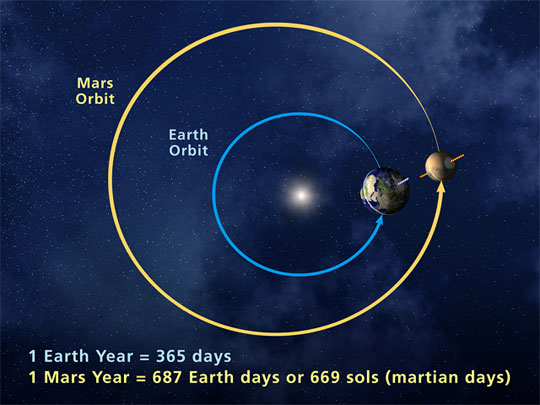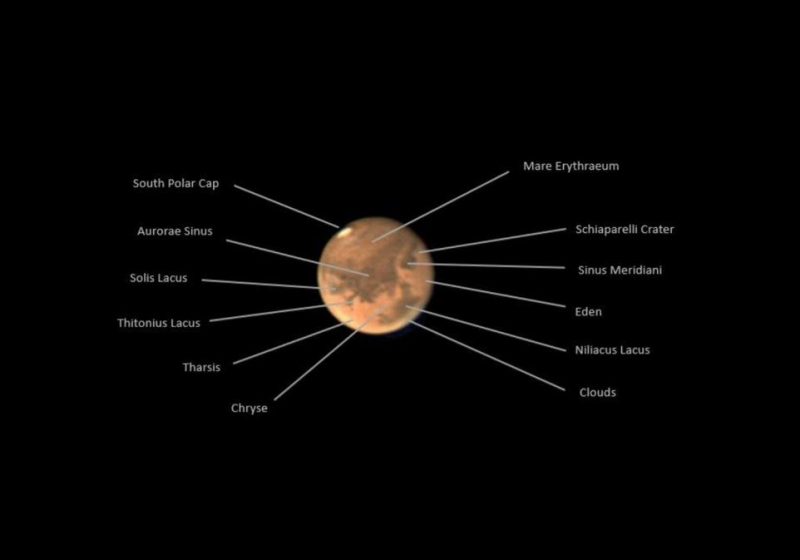
Remember the historically close approach of Mars in 2003? At that time, Mars was closer than it had been in some 60,000 years. Mars was only slightly farther, but still very close, in 2018. On October 6, 2020, at about 14 UTC, Mars is closest for this two-year period, only a bit farther away than in 2003 or 2018. October 6 of this year presents Earth and Mars closer together than they will be again for another 15 years, or until September 2035. For the continental U.S. and Canada, Mars’ closest approach comes on October 6, 2020, at at 10 a.m. EDT, 9 a.m. CDT, 8 a.m. MDT, 7 a.m. PDT, 6 a.m. Alaskan Time and at 4 a.m. Hawaiian Time. At that precise time, Mars is about 38.57 million miles (62.07 million km) from us. Of course, these moments of closest approach are fleeting as both Earth and Mars move in their orbits around the sun.
At its 2003 close approach – on August 27, 2003 – Mars was 34.65 million miles (55.76 million km) away.
At the 2018 close approach – on July 31, 2018 – Mars was 35.78 million miles (57.59 million km) away.
Mars won’t beat its 2003 performance until until August 28, 2287, when the red planet will be 34.60 miles (55.69 million km) away.
But, as we said above, Earth and Mars are closer on October 6, 2020 than they will be again for another 15 years, or until September 2035.
Have you seen Mars yet? You can see it easily with the eye alone as the resplendent red “star” in the east every evening, and in the west before dawn. In fact, dazzling Mars is easily the brightest starlike object to light up the evening sky. Only the planet Venus – the third-brightest celestial object, after the sun and moon – beams brighter than Mars. Yet Mars lords over the nighttime from evening until dawn, whereas Venus is relegated to the eastern morning sky.
Read more: The cycle of close and far Mars oppositions

Mars is closest in spite of the fact that Earth will swing between Mars and the sun at its opposition on October 13, 2020.
Why aren’t we closest to Mars on the day we pass between it and the sun? If both the Earth and Mars circled the sun in perfect circles, and on the same exact plane, the distance between Earth and Mars would always be least on the day of Mars’ opposition. But we don’t live in such a symmetrical universe. All planets have elliptical orbits and a perihelion (closest point) and aphelion (farthest point) from the sun.
Mars’ orbit around the sun takes 687 days in contrast to 365 days for Earth. It has a year nearly twice as long as ours. Earth’s farthest point from the sun comes yearly, in early July. Mars was at its closest to the sun on August 3, 2020. Ever since July 4, 2020, Earth has been moving closer to the sun; and ever since August 3, 2020, Mars has been edging away from the sun.
At its opposition on October 13 – when Earth will be directly between Mars and the sun – Mars will be farther from than sun than on October 6, 2020. On the other hand, Earth will be closer to the sun (and therefore farther from Mars) on October 13 than on October 6. That all adds up to Earth being slightly closer to Mars on October 6 than October 13.
The time interval between a Mars opposition and its least distance from Earth can be as long as 8.5 days (1969), or as little as 10 minutes (2208 and 2232).
Generally speaking, Mars is at its brightest in 2020 throughout the month of October 2020. It is now shining more brilliantly than the planet Jupiter, and it’s not very often that Mars outshines the king planet!

Is Mars brightest when it’s closest? Not necessarily.
You might think Mars should be brighter when closest to Earth on October 6 than at opposition on October 13. But it’s not (although it’s still plenty bright).
Mars is a tiny bit fainter now than it will be at its October 13 opposition. That’s because of something known as opposition surge. Mars reflects sunlight most directly back to Earth at opposition. This directness accentuates Mars’ brilliance. Before and after opposition, sunlight is reflected at a slightly slanted angle relative to Earth, thereby reducing Mars’ brightness.
Earth swings between Mars and the sun every other year, at progressively later dates. Earth will next lap Mars on December 8, 2022. Its closest approach to Earth that year will be December 1, 2022. After that, Earth will next lap Mars on January 16, 2025, but its closest approach will come on January 12, 2025. At both of those oppositions of Mars – and at every opposition for some years to come – Mars will appear fainter, and fainter, in our sky. That’s because those oppositions will happen closer and closer to Mars’ aphelion date.
In the year 2027, Mars’ opposition comes on February 19, 2027, and Mars sweeps closest to Earth on February 20, 2929. At a distance of 63.02 million miles (101.42 million km), this will present Mars’s most distant opposition in the 21st century (2001 to 2100). Mars reaches aphelion – it farthest distance from the sun – on March 2, 2027.
So enjoy Mars in October 2020! You won’t see it this bright again until September 2035.
Mars is out almost all night long now. It looks like a bright reddish “star,” shining with a steadier light than the true stars. In mid-October 2020, look for Mars in the east at nightfall – highest in the sky near midnight – and in the west as morning dawn starts to light the sky.
Clouded out tonight? Look tomorrow or the next night! Mars will remain dazzlingly bright in our sky for all of October.
Read more: The cycle of close and far Martian oppositions

Geocentric Ephemeris for Mars: 2020
Bottom line: The Mars opposition – when Earth flies between the sun and Mars – comes on October 13, 2020. But the distance between Mars and Earth is least on October 6, 2020. You can see Mars easily with the eye alone. It looks like a bright red “star” in the east every evening, in the west before dawn.











